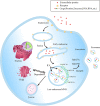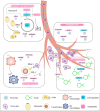Exosomal Non-Coding RNAs: Regulatory and Therapeutic Target of Hepatocellular Carcinoma
- PMID: 33869059
- PMCID: PMC8044750
- DOI: 10.3389/fonc.2021.653846
Exosomal Non-Coding RNAs: Regulatory and Therapeutic Target of Hepatocellular Carcinoma
Abstract
Exosomes are small extracellular vesicles secreted by most somatic cells, which can carry a variety of biologically active substances to participate in intercellular communication and regulate the pathophysiological process of recipient cells. Recent studies have confirmed that non-coding RNAs (ncRNAs) carried by tumor cell/non-tumor cell-derived exosomes have the function of regulating the cancerous derivation of target cells and remodeling the tumor microenvironment (TME). In addition, due to the unique low immunogenicity and high stability, exosomes can be used as natural vehicles for the delivery of therapeutic ncRNAs in vivo. This article aims to review the potential regulatory mechanism and the therapeutic value of exosomal ncRNAs in hepatocellular carcinoma (HCC), in order to provide promising targets for early diagnosis and precise therapy of HCC.
Keywords: early diagnosis; exosomes; hepatocellular carcinoma; non-coding RNAs; precise therapy; tumor microenvironment.
Copyright © 2021 Xia, Huang, Liu, Zhao, He, Wang, Shi, Chen, Li, Yu, Huang, Kang, Su, Xu, Yam and Cui.
Conflict of interest statement
The authors declare that the research was conducted in the absence of any commercial or financial relationships that could be construed as a potential conflict of interest.
Figures


Similar articles
-
Biological functions and clinical applications of exosomal non-coding RNAs in hepatocellular carcinoma.Cell Mol Life Sci. 2019 Nov;76(21):4203-4219. doi: 10.1007/s00018-019-03215-0. Epub 2019 Jul 12. Cell Mol Life Sci. 2019. PMID: 31300868 Free PMC article. Review.
-
The Potential Roles of Exosomal Non-Coding RNAs in Hepatocellular Carcinoma.Front Oncol. 2022 Feb 24;12:790916. doi: 10.3389/fonc.2022.790916. eCollection 2022. Front Oncol. 2022. PMID: 35280805 Free PMC article. Review.
-
Exosomal ncRNAs: Multifunctional contributors to the immunosuppressive tumor microenvironment of hepatocellular carcinoma.Biomed Pharmacother. 2024 Apr;173:116409. doi: 10.1016/j.biopha.2024.116409. Epub 2024 Mar 8. Biomed Pharmacother. 2024. PMID: 38460375 Review.
-
Exosomal Non-coding RNAs-Mediated Crosstalk in the Tumor Microenvironment.Front Cell Dev Biol. 2021 Apr 12;9:646864. doi: 10.3389/fcell.2021.646864. eCollection 2021. Front Cell Dev Biol. 2021. PMID: 33912560 Free PMC article. Review.
-
Non-coding RNAs in Cardiac Intercellular Communication.Front Physiol. 2020 Sep 9;11:738. doi: 10.3389/fphys.2020.00738. eCollection 2020. Front Physiol. 2020. PMID: 33013428 Free PMC article. Review.
Cited by
-
Exosomal delivery of non-coding RNAs: a pathway to apoptosis regulation in lung cancer.Med Oncol. 2025 Jul 1;42(8):307. doi: 10.1007/s12032-025-02852-9. Med Oncol. 2025. PMID: 40591081 Review.
-
Extracellular Vesicles-ceRNAs as Ovarian Cancer Biomarkers: Looking into circRNA-miRNA-mRNA Code.Cancers (Basel). 2022 Jul 13;14(14):3404. doi: 10.3390/cancers14143404. Cancers (Basel). 2022. PMID: 35884464 Free PMC article. Review.
-
Novel extracellular RNA biomarkers for early stage hepatocellular cancer.ExRNA. 2021 Dec;3:12. doi: 10.21037/exrna-21-23. Epub 2021 Dec 30. ExRNA. 2021. PMID: 35874619 Free PMC article. No abstract available.
References
Publication types
LinkOut - more resources
Full Text Sources
Other Literature Sources

